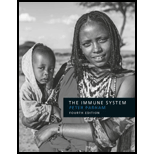
(a)
To write:
The types of cells which are restricted to the expression of MHC class II molecules.
Introduction:
MHC (major histocompatibility complex) class I molecules are among the two primary classes of MHC molecules which are present on the surface of all nucleated cells in the jawed vertebrate organisms. They are present on platelets but absent on the RBCs. MHC class I antigen arrangement path shows a significant function in warning the immune system to any kind of viral infection in cells. These are the peptide fragments derived from the intracellular proteins.
(B)
To write:
About the maximum types of cells present in the thymus or found in circulation through it and their function in mediating the two types of selection(positive or negative).
Introduction:
MHC (major histocompatibility complex) class I molecules are among the two primary classes of MHC molecules which are present on the surface of all nucleated cells in the jawed vertebrate organisms. They are present on platelets but absent on the RBCs. MHC class I antigen arrangement path shows a significant function in warning the immune system to any kind of viral infection in cells. These are the peptide fragments derived from the intracellular proteins.
(C)
To write:
The fate for non-circulating cells to produce MHC class II molecules in the thymus gland.
Introduction:
MHC (major histocompatibility complex) class I molecules are among the two primary classes of MHC molecules which are present on the surface of all nucleated cells in the jawed vertebrate organisms. They are present on platelets but absent on the RBCs. MHC class I antigen arrangement path shows a significant function in warning the immune system to any type of viral infection in cells. These are the peptide fragments derived from the intracellular proteins.
Want to see the full answer?
Check out a sample textbook solution
Chapter 7 Solutions
The Immune System, 4th Edition
 Human Anatomy & Physiology (11th Edition)BiologyISBN:9780134580999Author:Elaine N. Marieb, Katja N. HoehnPublisher:PEARSON
Human Anatomy & Physiology (11th Edition)BiologyISBN:9780134580999Author:Elaine N. Marieb, Katja N. HoehnPublisher:PEARSON Biology 2eBiologyISBN:9781947172517Author:Matthew Douglas, Jung Choi, Mary Ann ClarkPublisher:OpenStax
Biology 2eBiologyISBN:9781947172517Author:Matthew Douglas, Jung Choi, Mary Ann ClarkPublisher:OpenStax Anatomy & PhysiologyBiologyISBN:9781259398629Author:McKinley, Michael P., O'loughlin, Valerie Dean, Bidle, Theresa StouterPublisher:Mcgraw Hill Education,
Anatomy & PhysiologyBiologyISBN:9781259398629Author:McKinley, Michael P., O'loughlin, Valerie Dean, Bidle, Theresa StouterPublisher:Mcgraw Hill Education, Molecular Biology of the Cell (Sixth Edition)BiologyISBN:9780815344322Author:Bruce Alberts, Alexander D. Johnson, Julian Lewis, David Morgan, Martin Raff, Keith Roberts, Peter WalterPublisher:W. W. Norton & Company
Molecular Biology of the Cell (Sixth Edition)BiologyISBN:9780815344322Author:Bruce Alberts, Alexander D. Johnson, Julian Lewis, David Morgan, Martin Raff, Keith Roberts, Peter WalterPublisher:W. W. Norton & Company Laboratory Manual For Human Anatomy & PhysiologyBiologyISBN:9781260159363Author:Martin, Terry R., Prentice-craver, CynthiaPublisher:McGraw-Hill Publishing Co.
Laboratory Manual For Human Anatomy & PhysiologyBiologyISBN:9781260159363Author:Martin, Terry R., Prentice-craver, CynthiaPublisher:McGraw-Hill Publishing Co. Inquiry Into Life (16th Edition)BiologyISBN:9781260231700Author:Sylvia S. Mader, Michael WindelspechtPublisher:McGraw Hill Education
Inquiry Into Life (16th Edition)BiologyISBN:9781260231700Author:Sylvia S. Mader, Michael WindelspechtPublisher:McGraw Hill Education





